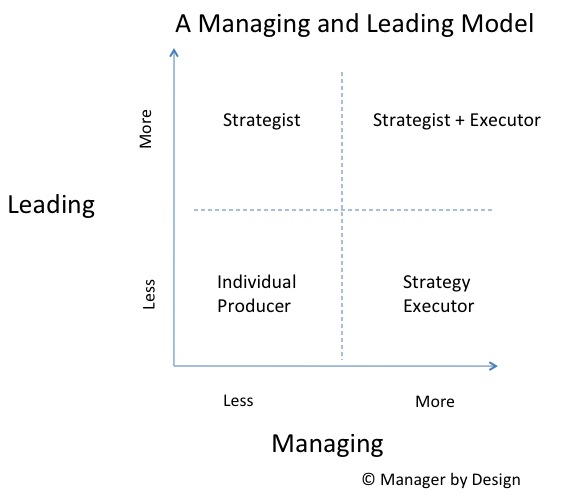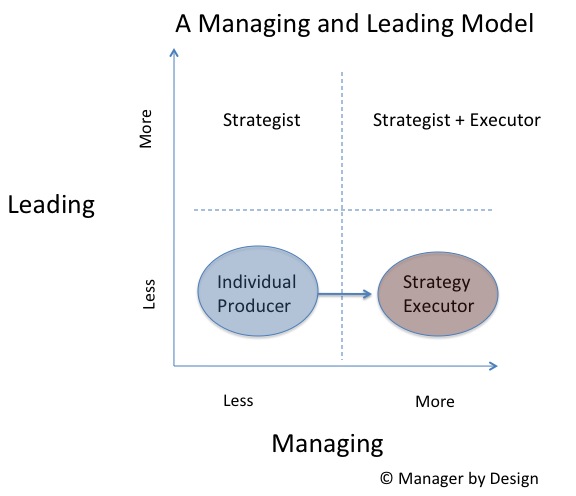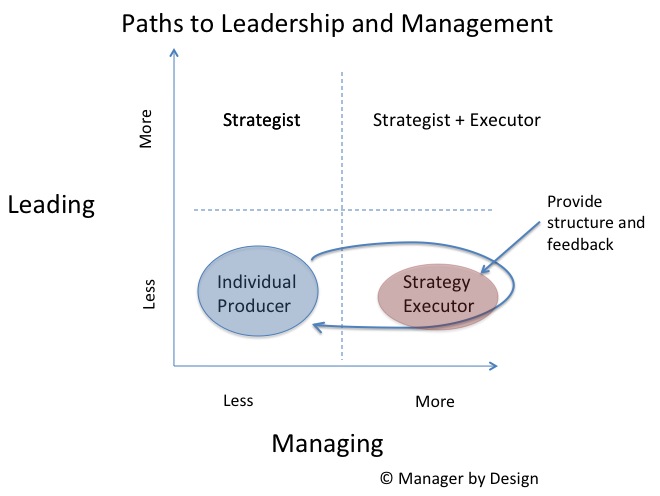How do managers learn strategy?
The Manager by Designsm blog believes that there is a distinction between management and leadership. Management is tied to strategy execution, and leadership is tied to strategy development. Having a better understanding of this differentiation can help improve the “designs” in which organizations develop both managers (strategy executors) and leaders (strategists). Sloppy management design, in turn, is when you expect both management and leadership skills get developed all at once, or are delivered to your organization via recruited “talent.”
Here is the Manager by Design leadership and management model:
In the commonly held notion of “becoming a manager”, the path looks like this:
In this notion, the individual producer becomes in charge of the team doing the producing. The new manager is in charge of “strategy execution.” This is a fine model if there is some structure and feedback in performing the new managerial role, and a terrible model if there is no structure and feedback. It all depends on the management design of the organization. Are the managers designed to be great? Or are they left to their own devices in determining and creating their management practices?
Assuming that the manager has guidance in the core people management practices, there is another potential flaw with this scenario: The manager does not develop strategy skills or does not appreciate the act of developing strategy.
If your organization is looking to create leadership capability (in my model, the “develop strategy” quadrant), then there are a few paths that can be designed in to help with this potential design flaw while doing the job of managing.
1. Create objectives aligned to the strategy and clean handoffs between the strategists and the strategy executors
2. Assure and encourage access to the strategists and articulation of the strategy
3. Temporarily and cleanly have the manager participate in the strategy process
4. Provide the structure and feedback in developing the strategy for the strategy execution
Having elements like these in your management design will improve how managers who are in charge of strategy execution understand better the strategy, and, in turn, execute the strategy. The emerging field of Management Design must take this into consideration, and create designs that encourage the interaction and handoff between strategy and strategy execution.
It is the goal of the emerging field of Management Design to encourage managers to seamlessly execute the strategy of an organization. If it is being done poorly or haphazardly, then you will not get strategy execution, a main task of management. You may get some sort of execution, but will you get strategy execution?
In upcoming articles, I’ll discuss these potential designs for assuring that managers know the strategy, contribute to the strategy process, and develop their own strategy setting skills.
Related articles:
Management Design: The designs we have now – Manager knows and supports only one possible strategy
Management Design: The Designs we have now: Part time strategist, part time manager
Current management design: The one with the ideas becomes the manager
Management Design: The Designs we have now: The paths to management and leadership
Management Design: An alternative path to management and leadership: Loop in and out
Management Design: Structure and Feedback in a focused area of leadership
Management Design: A proposed design so that new managers embrace learning management skills
Tenets of Management Design: Focus on the basics, then move to style points
Management Design: A proposed design so that new managers embrace learning management skills
In my previous article, I discussed how an improved design would be to have structure and feedback provided to those who take on a leadership/strategy role, however temporary. This way, they learn strategy while doing strategy. Seems simple enough, but how often is it done?
Now let’s transition the discussion away from leaders and to managers. In the Manager by Designsm leadership and management model, we can see how managers can learn their role using structure and feedback, and that it is possible to loop into the role and back out of it:
If someone goes into a team management role, they reason they have done this is to assure some sort of strategy execution. Sounds pretty important! So this sounds like a design requirement – makes sure someone is good at strategy execution.


